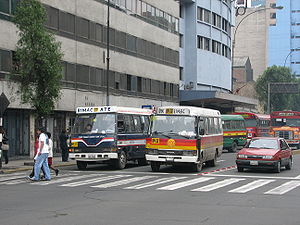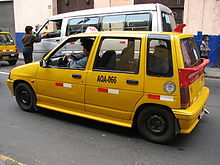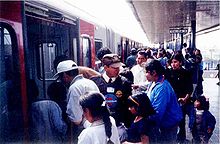- Transport in Lima
-
Public transport in Lima is handled by buses, micros, taxicabs, and the so-called mototaxis. Micros are the most common means of public transportation in Lima and many other cities in Peru. There are also more than 100 km of cycle paths in the city. The word micro is used in common-day Peruvian Spanish as an abbreviation for microbus (minibus). While the bigger vehicles are known as micros, the smaller ones are known as either combis or micros. These privately-owned vehicles are not only known for being very cheap and convenient but also for being rather risky.
Micros race from one street corner to another along all the major arterial city roads. Stickers saying, for example, "Todo Arequipa" or "Todo Benavides" can be seen on their windscreens, which indicates that the micro runs the whole length of Avenida Arequipa or Avenida Benavides. These microbuses dash dangerously fast, frequently crashing and speeding off before their passengers have got both feet into the vehicle. There being few bus stops, micros and combis pick and drop passengers anywhere along their route (although it is not allowed). Tickets became compulsory in the late-80s. No transfer tickets are issued, so double fares are often used by people when a micro passing through downtown does not go to the destination needed, although with the lack of control of routes nowadays there are many routes that go just about everywhere within the city limits. The only places where micros are no longer allowed to circulate is in the crosstown streets within downtown Lima: if you need to go from the West Side to the East Side you must walk or take a taxi (see below), and micros go north-south only through either the West or East sides' main arteries, Tacna Ave. and Abancay Ave. respectively.
Contents
Pollution
There are approximately 60 000 micros in Lima. A lot of them are old school buses brought from the United States or native-made bus bodies fitted to truck chassis engines. A few richer transportation companies use modern bodies made in Brazil or Argentina. Smaller companies use smaller vehicles such as minibuses (e.g. Toyota Coasters) and minivans.
Since almost all of these vehicles are poorly maintained, they produce a great amount of pollution. Statistics show that in July 2001, the amount of nitrogen dioxide (NO2) was of 236.66 mg/m³, the maximum allowable quantity being 100 mg/m³[citation needed]. The presence of small particles of different materials (dust, lead and other metals), was also high during this month: 294.12 mg/m³, while the allowed limit is 150 mg/m³[citation needed].
Vehicles
The most popular vehicle types used by the small micros (combis) are Toyota HiAce and Nissan Urvan microbuses, while the bigger micros are usually Toyota Coaster or Mitsubishi Fuso Rosa vehicles. A few older bus lines from the pre-combi era use large forty-odd year old buses.
Routes
Each transport company has its own routes, which usually pass through many districts. All routes can be found on TransporteLima.com Some of the routes in the Lima and Callao Metropolitan Area are:
- Ate - Callao (Routes CR20; CR25; CR57; CR71; CR75; IM04; IM24; IM31; IM33; IM40; IO01; IO04; IO27; IO61; IO64; IO67; IO81 and IO88)
- Carabayllo - Miraflores (Routes NO03 and NO99)
- Carabayllo - Pachacámac (Route EM01)
- Chorrillos - Ventanilla (Route IO03)
- La Punta - Pachacámac (Routes IO57; IO75; OM57 and OM62)
- San Bartolo - San Miguel (Routes SO16 and SO18)
- San Juan de Miraflores - Carabayllo (Routes NM24; NM33 and SO20)
- San Juan de Miraflores - Downtown Lima (Routes SCR08 and SCR35)
- San Juan de Miraflores - San Juan de Lurigancho (Routes EM05; EO07; EO65 and SM24)
- Santa Anita - La Molina (Route EM17)
- Santiago de Surco - Ancón (Route NO02)
- Santiago de Surco - San Isidro (Route SCR10)
- Santiago de Surco - Downtown Lima (Routes SCR25 and SM31)
- Villa el Salvador - San Juan de Lurigancho (Routes EM37; EM43; EO17; EO25; EO65A; EO65B; SO11 and SO30)
This is not an exhaustive list and only provides a few examples of micro routes.
Some older routes –generally those not using combis or similar-sized vehicles– can be defined by their old numbering until the early 1990s. The old route number is usually prominently displayed on the "passenger" side of the front window, as a backward reference. Many modern routes, however, lack this number. Old route numbers still well known (as of 2007) are # 2 (route IO35), 6 (route SO13), 8 (route EO21), 9 (routes EO64 and IO33), 23 (routes EO17; EO18 and EO101), 31 (route SO28), 39 (route SO20), 45 (routes EO107; IO43 and IO46), 48 (route IO53), 60, 66, 71 (routes IO63 and IO64), 91 (routes EM40 and EO26), 94 (route IO65), 102 (routes CR52 and IO79), 104 (routes EM35 and EO20), 148 (route NM32), and 150.
If one company branches out into many routes (generally overlapping at the center of the route) the different routes may be differentiated by letters: 104A, 104B, 104C, and so on, for instance. 104A (This route isn't available) goes from Penal section of San Juan de Lurigancho to San Miguel via the East Side of downtown; 104B (route EM35) goes from Mangomarca section of SJL (the original terminus) to San Miguel via the East Side; and 104C (route EO20) goes from Mangomarca to Miraflores, via the West Side.
Combi culture
The kombi operates within the districts of Lima, mainly; Kombi is an abbreviation of the German word Kombinationfahrzeug. The term was originally used to designate Volkswagen pickup introduced in the 1950s, they now come in several brands.
In the 1990s, during the government of the president Alberto Fujimori, it was established that the number of buses were not enough to transport people around the city, and the use of secondhand automobiles (mostly kombis) from others countries was permitted.[1] Kombi accidents in metropolitan Lima account for 45% of all accidents.[2]
Taxis
Taxis in the city are very cheap. There are no meters so you must tell the driver where you want to go and agree on a price before you get in. Since there are no meters, many taxi drivers overcharge inexperienced foreigners with high cab fares.
They vary in sizes from small four door compacts (generally Korean Daewoo Ticos) to large vans capable of transporting many pieces of luggage from the airport to your destination. They are virtually everywhere, accounting for a large part of the car stock. Often they are just any random car with a taxi sticker on the windshield. As in other major cities the way to flag them down is to wave your hand up high. Also much more expensive but more secure and professional are the Taxi Seguro's which you call up. They pick you up in their company cars. There are many different Taxi Seguro companies in Lima. Taxis will take you virtually anywhere in the city. You can tell them to take you to a certain hotel, tourist destination, or mall and they will probably know how to get there. Citizens of Lima commonly joke that they have the most educated taxi drivers in the world. The joke is based on the fact that taxi-running is a major source of income for unemployed or under-employed people, including professionals with a university degree who either rent or own the cars they drive. A whole economy spreads from investments in vehicle acquisition to be later rented as taxi cabs.
Taxis are the most efficient and fastest way of transportation in Lima, however they are also considered somewhat risky since some criminals disguise as taxi drivers and steal from the confident passenger at gunpoint later on. An indication of the security of the Taxi is to check if it has the label of the Setame on the windshield, which stands for Servicio de Taxi Metropolitano, the administrative authority that regulates taxi cabs. Setame taxis are in most cases painted in a distinctive yellow colour. Taxis without the Setame label are considered to be informal and risky.
Mototaxis and pedicabs are used in peripheral districts such as Puente Piedra and Comas where there isn't larger traffic, although with the spread of urbanization and routes they are losing ground to regular micros.
Metro (Urban Train)
The "Urban Train of Lima" is the electric mass transit system of the Lima Metropolitan Area in Peru. It currently consists of one 22 km line and sixteen stations, joining the southern area of the metropolis with the center of the city. Six additional lines are planned.
In 2010 the current government of Alan García retakes the project of Lima Metro starting with the construction of Line 1. The construction and implementation of 11.7 kilometres (7.3 mi) (with a total of 22.5 kilometres (14.0 mi)) of viaduct elevated of double ramp from the Atocongo Bridge to downtown Lima. The Lima Metro Line 1 is being built by a consortium made up by two engineering and construction companies. It is estimated by December 2010 the end of the civil works, remaining just the electrification of the line, which is in charge of Siemens. This first part of Line 1 must be completed at June 2011 and starts daily operations in July 2011.
Metropolitano
The Metropolitan Transportation System is a transport project which plans to integrate the Independent Corridor of Mass-Transit Buses known by its Spanish initials as (COSAC 1). This system links the principal points of the Lima Metropolitan Area and the first phase of this project has thirty three kilometer long line from the north of the city to Chorrillos in the south of the city. This system is similar to the TransMilenio of Bogota, Colombia.[3][4]
Air transport
Lima is served by the Jorge Chavez International Airport, located in Callao. It is the largest airport of the country with the largest amount of domestic and international air traffic. It also serves as a major hub in the Latin American air network. Additionally, Lima possesses five other airports: the Las Palmas Air Force Base, Collique Airport, and runways in Santa María del Mar, San Bartolo and Chilca.[5]
See also
Lima and Callao Metropolitan Area Culture · History · Landmarks · Notable people · Mayors · Other elected officials · Transportation Districts Central Lima Breña · La Victoria · Lima · Rimac South Central Lima Barranco · Jesús María · La Molina · Lince · Magdalena · Miraflores · Pueblo Libre ·San Borja · San Isidro · San Miguel · Santiago de Surco · Surquillo Cono Este Ate · Cieneguilla · Chaclacayo · El Agustino · Lurigancho (Chosica) · San Juan de Lurigancho · San Luis · Santa Anita Cono Norte Ancón · Carabayllo · Comas · Independencia · Los Olivos · Puente Piedra · San Martin de Porres · Santa Rosa Cono Sur Chorrillos · Lurín · Pachacamac · Pucusana · Punta Hermosa · Punta Negra · San Bartolo · San Juan de Miraflores · Santa María del Mar · Villa el Salvador · Villa María del Triunfo Callao Bellavista · Callao District · Carmen de la Legua Reynoso· La Perla · La Punta · Ventanilla References
- ^ "Decreto ley N° 26120 - modifica la ley de Promoción de la Inversión privada en las Empresas Del Estado, 2". pdf. http://proinversion.gob.pe/RepositorioAPS/0/0/JER/MARCOLEGALTRIBUTARIO/15-D_L_26120.pdf. Retrieved 10/11/2011.
- ^ "Transporte Urbano". pdf. http://www.inei.gob.pe/biblioineipub/bancopub/Est/Lib0047/CAP-3.3.htm. Retrieved 9/11/2011.
- ^ http://www.metropolitano.com.pe/
- ^ http://www.TransporteLima.com/
- ^ http://gc.kls2.com/
Categories:- Public transport in Peru
- Transport in Lima
Wikimedia Foundation. 2010.




